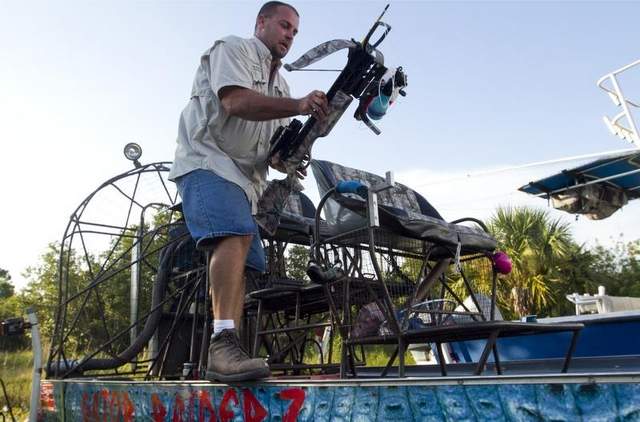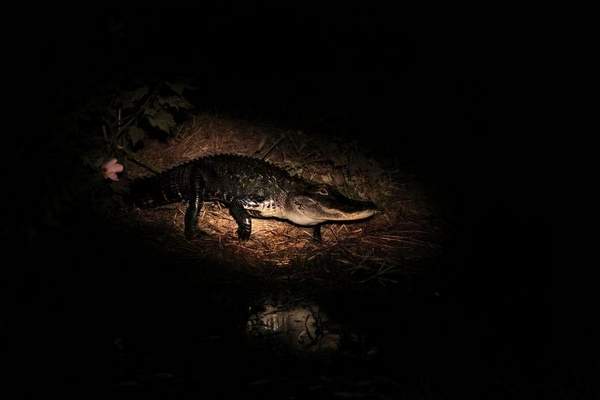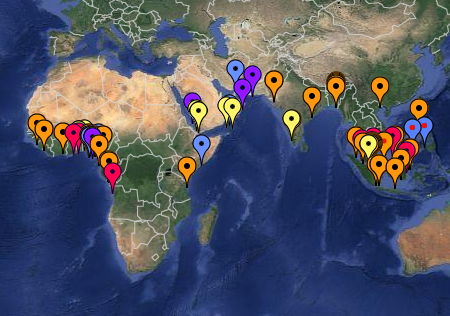alligator hunting season gets started
posted: 14 August 2012
by: Michael Braun
Florida’s 11-week statewide alligator hunting season gets started at 5 p.m. today.
All 5,700 state alligator harvest permits have been sold, said Tony Young, media relations coordinator for the Florida Fish and Wildlife Commission’s Division of Hunting and Game Management. Permits allow a two-gator harvest and cost $272 for residents or $1,022 for out-of-state hunters. If all tags are used, Young said, that would be 11,400 gators harvested.

Dave Smith checks his crossbow on his airboat near his Punta Gorda home in preparation for today’s opening of alligator hunting season. Smith is a hunting and bow fishing guide.
“But not all tags are filled each year,” he said.
Alligators are known to be in all 67 Florida counties — in lakes, rivers and swamps to the golf courses, retention ponds or even the odd suburban swale. Young said the first four weeks of the season are called quota weeks and are scheduled that way to prevent hunting areas from becoming jammed. “It keeps the busy areas of the state’s waters from getting overcrowded,” he said. Young, who hunts gators himself, said it is a different type of hunting.
“It is kind of a combination of fishing and hunting,” he said. “The methods of taking a gator are kind of like fishing.” Young said that most hunters want to draw their permits in the first of those quota weeks. “If you don’t harvest in the first week or you don’t use both your tags, then you can’t hunt in the following three weeks,” he said. “But you then can hunt from Sept. 12 to Nov. 1.”
Go with a guide
Those who wanted to hunt but did not get a permit in time can contact a guide or outfitter. “There are outfitters who buy permits so they can take people out on hunts,” Young said. He also said that nuisance gator trappers are allowed to take people hunting when they have a problem gator to harvest. “They are allowed to take you on a hunt,” he said. “And this is 24/7, not just in season.”
Dave Smith of Punta Gorda runs Gator Raiderz outfitters and guides and plans to be running hunting trips this year. “We went out about 30 times last year,” he said. “We mainly use bow and arrow, crossbow and harpoon.” Smith says his service will take hunters all over Central and South Florida, Lake Okeechobee and Lake Trafford as well as other areas. Smith, who has been gator hunting 20 years and guiding for the past 10, said the biggest he’s harvested was a 12-footer. “The average size is about 8 to 9 feet, with a few 10-footers,” he said. Smith says he provides everything for hunters going out with his service. “It’s real easy,” he said. “We just go over everything before we go out.”
Hunters can venture out at 5 p.m. each day during the season and look to get their gator until 10 a.m. the next day. “Gator hunting is traditionally a night hunt,” Young said, adding sometimes people get a gator late into the morning hours and are still trying to land the beast as daylight spreads.
Additionally, Young said, hunters can go out during the season before 5 p.m. to scout gator areas. “They can bass fish, or water ski or just go pleasure boating,” he said.
Those looking to fill their gator tags can use a variety of methods, Young said. “There are no guns allowed,” he said. “But you can use a harpoon or spear, a compound bow, re-curve bow, crossbow, a spinning reel with a big treble hook to snag the gator or a 2-inch wooden peg.” The peg method uses bait, like beef lung, to entice the gator to swallow the piece of wood. “The hunter will place the bait near the gator and wait for them to swallow. When they do it gets stuck in their throat,” Young said. The peg is tied to the boat with line and the hunter then waits for the gator to tire itself out. “The line has to be tied to the boat and the boat has to be manned,” Young said. Young also said though guns are not allowed, a bang stick, a specialized firearm used underwater is allowed to dispatch the gator after it is brought alongside the boat.



